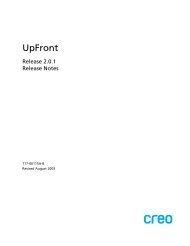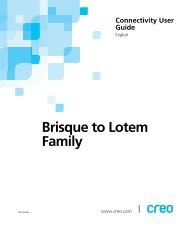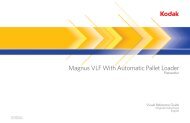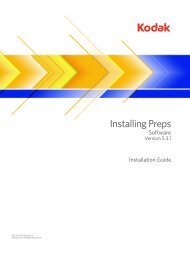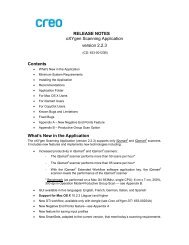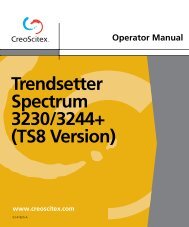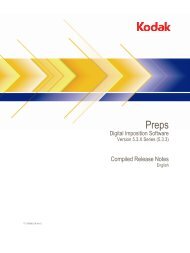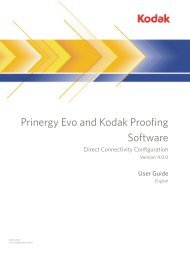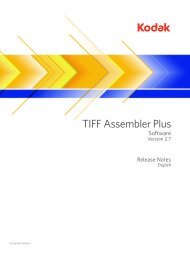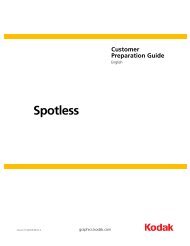Brisque to Lotem 800 II / Lotem Quantum Family - Kodak
Brisque to Lotem 800 II / Lotem Quantum Family - Kodak
Brisque to Lotem 800 II / Lotem Quantum Family - Kodak
- No tags were found...
You also want an ePaper? Increase the reach of your titles
YUMPU automatically turns print PDFs into web optimized ePapers that Google loves.
58 Chapter 2 – Configuring and Calibrating the <strong>Lotem</strong> <strong>800</strong> <strong>II</strong> / <strong>Lotem</strong> <strong>Quantum</strong> <strong>Family</strong> from the <strong>Brisque</strong> WorkstationAngle SetTo designate the screen angles for the different color separations. Angle se<strong>to</strong>ptions are: Conventional, Shifted, and Pseudo Conventional, whichmodify the angles set in the default Screen Sets. These variations are aresult of extensive labora<strong>to</strong>ry and field tests, designed <strong>to</strong> prevent moiré andother interference patterns.1. To define an Angle set, click the Angle but<strong>to</strong>n and from the menu,select an Angle set option. The screening angles for each separation, asdefined by the Angle set, appear in the angle boxes beneath theseparation names.2. To cus<strong>to</strong>mize the screening angle for a specific separation, clickinside the Screening Angle box in the column below the separationname, and type in a new angle.When screening a Job containing Spot Colors, the resulting Plate Exposealways outputs the Spot Colors at 45 degrees, regardless of the Spot Angleparameters defined in the Screen Set.Tip: When Angles are set <strong>to</strong> 45 degrees for any CMYK color separation, youcan set the au<strong>to</strong>matically fine-tune all Screen Frequency values (including Spotcolors) <strong>to</strong> prevent patterns. To use this feature check the Adjust Scr. Freq. box.You can also enter an Angle value of 0, but a Screen Frequency adjustment onlyfor that particular color separation will be calculated.Screen FrequencyThe Screen frequency, also known as screen ruling or mesh, determines thenumber of “printed dots" rows per millimeter, that are exposed on theplate.Common screen frequencies range from 3 - 12 lpi. Screen frequenciesdefined in the default Screen Sets provided by Creo have been calculated <strong>to</strong>give the best dot structure and <strong>to</strong> be least likely <strong>to</strong> produce unwantedpatterns.Tip: Screen frequencies above approximately 7 lpi typically result in differentdot gain characteristics on press. To compensate for this, use a ToneReproduction curve. See Tone Reproduction on page 42.To define a Screen Frequency for all separations, select the Adjust checkbox and type a value in the Scr. Freq. box.



